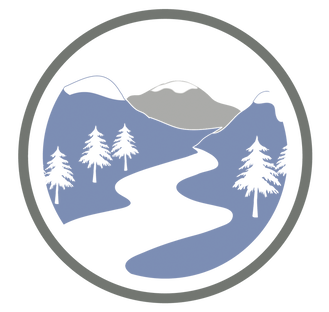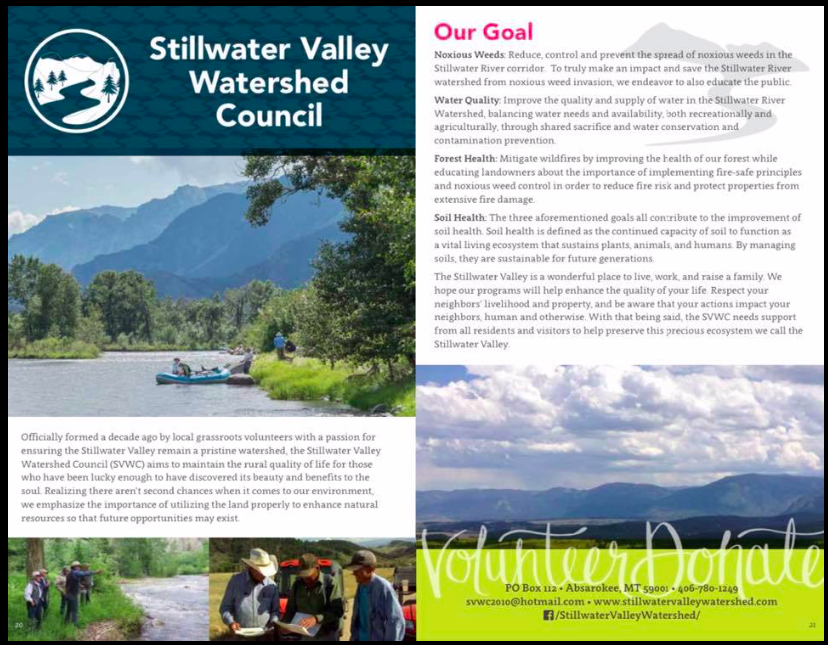ABOUT THE SVWC
HistoryIn 2006 the Stillwater River Weed Management Area was formed to control weeds along the uppermost part of the river. This group was funded through a three year Grazing Lands Conservation Initiative Grant ($122,000) and involved the Forest Service, Stillwater Mining Company, Stillwater County Weed District and over 95 local landowners. The project was extremely successful in controlling the weed invasions in the area. However, the ultimate goal of the group was to continue this systematic approach to weed management downriver, utilizing this project as a model to be followed and expanding the collaborative conservation effort. As the grant moved to a close and the success of the weed management area became apparent, the continuation of collaboration and cooperation on weed management expanded. Water quality, forest health and related educational efforts required a formalized structure. This structure, the Stillwater Valley Watershed Council, was officially formed in 2010.
|
Our MissionThe Stillwater Valley Watershed Council will provide an open forum in which all interested parties may work in a collaborative effort to sustain our rural quality of life to protect and enhance our natural resources. We seek to understand all points of view, come to a common goal and work for practical solutions. We are committed to research and educating valley residents and the public about our watershed and the steps we can take to preserve and maintain the integrity of the river, the land and the beauty of our valley. As a group of dedicated volunteers, we have received dedicated support from Stillwater County Weed District, Stillwater Conservation District, Stillwater Sibanye Mining, MT Fish, Wildlife & Parks, US Forest Service, Rocky Mountain Elk Foundation, local community foundations, among others. The SVWC will endeavor to bring together public, private and government resources, funding, and grants to achieve our goals.
|
Board of DirectorsThe Board of Directors is comprised of twelve community volunteers who are elected from within and by the Council to serve three year term. Terms are staggered with four members elected each year, with preference given to members not already on the Board. The Board will meet quarterly, or on an as, need basis. Meetings are open to the public.
The current board members are: Tim Schaff, Chairman Chris Fleck, Vice Chair Cedar Magone, Secretary Fay Espeland, Treasurer Butch Behrent Laura Blond Noel Keogh Tom Kircher Karen Marts Bill Mytton Dirk Pelton Tyrele Schaff |

It is with great pleasure that we look back at past board members and dutifully thank them for their years of service to our watershed:
- Judy Bostedt (2010-2012)
- Greg Frokjer (2010-2013)
- Mike Lorash (2010-2014)
- Doug Robinette (2010-2014)
- Olaf Sherwood (2010-2015)
- Sandra Peck (2010-2017)
- J.O. Hash (2010-2018)
- Bill Mytton (2010-2018)
- Cindy Green (2013-2018)
- Clint Branger (2015-2018)
- Raymond Lien (2015-2020)
- Theo Yanzick (2010-2023)
- Chase Ostrum (2020-2023)
"A watershed can be simply described as an area of land draining into a spcific point. The functions of a watershed are to capture, store, and release water. Land use changes can disrupt the natural function of a watershed, resulting in erosion of streams, flooding, and a decline in water and land quality." Jennifer Mohler, Bridger Scientific, Inc

